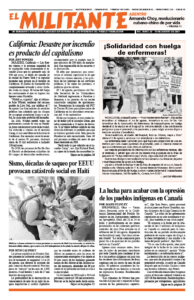NEW YORK — Why does Cuba’s socialist revolution continue to live, fight and set an example worldwide more than 60 years after workers and farmers there took power? What makes class and social relations in Cuba so different from anywhere else in the world today?
Because 62 years ago the working people of Cuba were led by a Marxist leadership to make a socialist revolution, Martín Koppel and Róger Calero told a Militant Labor Forum here Aug. 14. Both are members of the Socialist Workers Party; Calero is the party’s candidate for mayor of New York.
“The revolutionary government was a new state power — workers power — that organized workers, farmers, youth and others,” Koppel said. “A socialist revolution is marked by a different kind of social relations, based on working-class solidarity, not capitalist competition.”
“There were two great socialist revolutions in the 20th century, one in Russia, the other in Cuba,” Koppel said, quoting from a letter sent by SWP National Secretary Jack Barnes to Cuban President Raúl Castro in November 2016 after the death of Fidel Castro (reprinted in this issue). In it Barnes noted that Castro’s “highest achievement was forging in struggle a revolutionary cadre, a communist cadre, capable of leading the workers and farmers of Cuba to establish the first free territory of the Americas and successfully defend it for more than five and a half decades” — now more than six! — “against the determination to destroy it by the mightiest and most brutal empire the world has known.”
The Cuban Revolution has been distinguished from the start by its proletarian internationalist record — sending volunteer combatants to aid anti-imperialist struggles, or doctors and nurses to respond to earthquakes and hurricanes, and to combat Ebola and COVID-19.
“The U.S. rulers fear that workers and farmers around the world, including here in the United States, will follow the living example of Cuba’s socialist revolution,” Koppel said.
Transformation of social relations
The leadership of the Cuban Revolution instilled in working people confidence in their own capacities to transform and lead society, Koppel said. This transformation began during the revolutionary war itself, as the Rebel Army began to organize working people in liberated regions to take charge of health care, education, justice and agriculture.
In the days following the Jan. 1, 1959, popular insurrection that toppled the U.S.-backed dictatorship of Fulgencio Batista, the Rebel Army crossed the island and in every town along the way Castro spoke with crowds of workers and peasants to explain what they were fighting for.
Peasants were led to carry out a sweeping land reform. Workers “took more and more control of job conditions. They expropriated the capitalists’ factories, banks and big landholdings, and began to organize the economy to meet the needs of the majority, not the profits for a small exploiting class,” Koppel said. “Decisive steps were taken to outlaw racist discrimination, and to draw millions of women into economic, social and political activity.”
In 1961 an army of volunteer teachers, largely teenagers, spread across the countryside and wiped out illiteracy in a year, which also helped break down divisions between working people in city and country, Koppel said. That April the Cuban people defeated a U.S.-organized mercenary invasion in less than 72 hours.
As they were doing this, Koppel said, the Cuban leadership set out to “lend support to those around the world who were fighting to be free of imperialist oppression — from Algeria to Angola, a course of international solidarity that continues to this day.”
It’s these class relations, based on the expropriation of the capitalist exploiters and built over decades of promoting working-class consciousness, that make Cuba’s revolution different. This is why the U.S. rulers are determined to destroy it. And why it’s so important for working people the world over to defend it.
Cuba, like the rest of the world, is affected by the world capitalist economic crisis, Koppel said. The embargo imposed by Washington, and enforced on other countries, sharply limits Cuba’s access to the hard currency needed to buy food, fertilizer, fuel, medicine, spare parts, and other necessities. The embargo is compounded by the pandemic, which has decimated tourism, a major source of hard currency.
“Despite these challenges the Cuban government has sought to guarantee medical care and basic necessities to the population and to involve it in the process,” Calero said.
In response to a question from the audience, Koppel noted the collective response of the Cuban people to the pandemic. “No one has been left to fend for themselves,” he said. “And Cuba has now fully vaccinated a quarter of the population with their own extremely effective vaccine. They’ve done this while maintaining nearly 30,000 volunteer medical personnel around the world.”
On July 11 protests took place in Cuba “orchestrated by groups and individuals opposed to the revolution that receive funds from the U.S. government,” Calero said. “These groups took advantage of the hardships and effects of Washington’s sanctions that have been building up. Many people, including some who support the government, were drawn into the protests because they see no end to the difficulties they face.”
This is compounded by shattered illusions among some Cubans who had hoped that President Joseph Biden would reverse some of the most draconian restrictions of Washington’s punishing embargo.
But seeing the pressures in Cuba that are building up, the U.S. rulers have no intention of backing off their bipartisan effort to tighten the economic squeeze aimed at overthrowing the Cuban Revolution — an effort carried out by the previous 12 U.S. administrations since 1959.
Both open enemies of the revolution as well as liberals and “socialists” are part of the current political offensive against the Cuban Revolution, Calero said. He gave the example of Alexandria Ocasio-Cortez, the Democratic Party socialist congresswoman from New York, who calls for an end to the embargo while backing the recent U.S.-provoked protests in Cuba, repeating “the timeworn slanders that the Cuban government is a dictatorship that violates human rights.”
In the discussion one participant noted that among many in the U.S. who oppose the embargo there are those who say we should downplay the socialist revolution. They say this is the best way to win “progressive” politicians and businesses who might join in calling for ending aspects of the embargo for their own reasons, a strategy they argue is more likely to succeed. Behind this is their prejudice that “backward U.S. workers” can never be won to support a socialist revolution.
“The stronger the revolution is, the better the chances to force the U.S. rulers to back off their attacks on it,” Koppel said. “That’s the lesson of history.”
Defense of the Cuban Revolution is part of advancing the class struggle here, he said. “The best aid we can give to the Cuban people is to advance working-class struggles in the U.S.,” Calero said.
“The lessons of the Cuban Revolution and its Marxist leadership can’t be separated from the task of building a communist party here to lead the working class to power in the United States.”
“For young people and workers who are waking up to the crisis of capitalism today and want to do something about it, taking the time to study, absorb and use the lessons of the Cuban Revolution will prove decisive in who will win the class battles to come — the working class or the fascist thugs the capitalist rulers will unleash,” Calero said. That’s why the Socialist Workers Party spends so much time publishing and promoting study of books by leaders of the revolution.
Calero pointed to the efforts by the Cuban government and mass organizations to enable every Cuban — including those with physical and other disabilities—to participate actively in society and realize their full potential. This includes everything from film programs for the blind to special steps, in face of the embargo, to ensure hearing aids and other equipment for those with special needs.
Human solidarity vs. barbarism
“It is the deeply ingrained sense of social solidarity and internationalism that underlies the Cuban people’s determination to defend the conquests of the revolution and to advance the social and political aspirations of working people around the world,” Calero said.
“Socialist revolution draws on human diversity. It seeks to provide human beings with the scientific and cultural advances that have accumulated over centuries of human activity, to allow for the development of every person to their fullest potential. This has been a guiding principle of the Cuban Revolution from the beginning.
“These values can only be produced by a socialist revolution. Values that millions of working people in the United States can recognize and be won to fight for,” Calero said.
Economic instability, war crises and class battles of major proportions lie ahead, he said. Pointing to midtown Manhattan with its boarded-up stores and thousands of homeless workers, he said, “That’s what Cuba was like for working people before the revolution, and what capitalism has to offer today.
“The Socialist Workers Party sees building a revolutionary working-class party in the United States as the central task in defense of the Cuban Revolution. We invite you to join us.”


